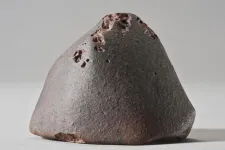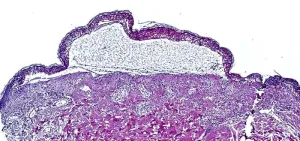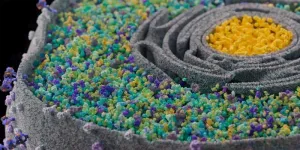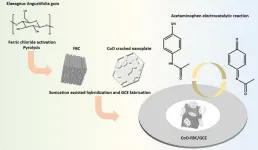(Press-News.org) Tokyo, Japan – Unwanted heating of electronic components hinders the performance of many devices. For example, the processing speed and memory available to silicon-based computer chips depend strongly on the ability to dissipate heat effectively. Unfortunately, despite high demand, thermal management remains challenging.
Now, in a study published in Nature, a team of researchers led by the Institute of Industrial Science, the University of Tokyo, has demonstrated the ability to control heat transfer in graphite crystals. Their novel approach applies concepts from fluid dynamics to phonons in solid-state crystals.
Phonons are ‘quasiparticles’, characterized by the collective vibration of atoms or molecules in condensed matter. Crystals consist of repeating patterns of atoms, arranged uniformly throughout the material.
“Bonds in a crystal act like springs when atoms become excited—for example, by heating. These ‘springs’ then act in unison, forming a wave, or phonon, that travels through the crystal,” explains Xin Huang, lead author of the study.
Interestingly, one way that phonons can travel through solid-state crystals bears a striking resemblance to the flow of fluids, in a phenomenon known as ‘hydrodynamic phonon transport’. Huang and collaborators have exploited this effect to realize thermal rectification in graphite.
They fabricated structures inspired by Tesla valves, originally designed by Nikola Tesla in the 1920s. Tesla’s ‘valvular conduit’ can force fluids to flow more quickly in one direction than another. This concept can also be applied to thermal flow via phonons in a crystal, allowing the heat to be dissipated more evenly.
The thermal conductivity of the Tesla valve—which describes the ability of a material to conduct heat—was measured across a range of temperatures, from 10 K to 300 K. Its asymmetric design allows unhindered hydrodynamic phonon transport in the forward direction and resists the flow in the reverse direction. The efficiency of rectification, or ‘diodicity’, is given by the ratio of thermal conductivity between the forward and reverse directions.
At low temperatures of 10 K, the diodicity had a value of 1. As the temperature increased, this parameter reached a maximum value of 1.15 (at 45 K), indicating a more efficient flow of heat in the forward direction. This effect was evident up to 60 K, but the effects of phonon scattering at higher temperatures caused the thermal conductivity to equalize in both directions.
The exploitation of this effect is currently limited both to the low-temperature regime and to materials that exhibit hydrodynamic phonon transport (which excludes silicon).
“What’s exciting, though, is that theoretically there are no barriers to achieving thermal rectification across a wider temperature range, even reaching room temperature,” says Masahiro Nomura, senior author.
Beyond this basic research in condensed matter physics, this phenomenon could eventually be applied to wide range of devices, enabling manufacturers to develop advanced thermal-management systems to optimize the performance of electronic components such as smartphones, computers, and LEDs.
###
The article “A graphite thermal Tesla valve driven by hydrodynamic phonon transport” was published in Nature at DOI: 10.1038/s41586-024-08052-1.
About Institute of Industrial Science, The University of Tokyo
The Institute of Industrial Science, The University of Tokyo (UTokyo-IIS) is one of the largest university-attached research institutes in Japan. UTokyo-IIS is comprised of over 120 research laboratories—each headed by a faculty member—and has over 1,200 members (approximately 400 staff and 800 students) actively engaged in education and research. Its activities cover almost all areas of engineering. Since its foundation in 1949, UTokyo-IIS has worked to bridge the huge gaps that exist between academic disciplines and real-world applications.
END
An international team led by three researchers from the CNRS1, the European Southern Observatory (ESO, Europe), and Charles University (Czech Republic) has successfully demonstrated that 70% of all known meteorite falls originate from just three young asteroid families. These families were produced by three recent collisions that occurred in the main asteroid belt 5.8, 7.5, and about 40 million years ago. The team also revealed the sources of other types of meteorites; with this research, the origin of more than 90% of meteorites ...
The researchers used spatial proteomics to analyze skin samples from patients with toxic epidermal necrolysis. This cutting-edge approach, known as Deep Visual Proteomics, merges powerful microscopy with AI-driven analysis, laser-guided microdissection and ultimately ultra-high sensitivity mass spectrometry. They zoomed in on individual cells and studied them like never before, creating a map of the thousands of proteins driving this deadly reaction.
Thierry Nordmann, first author, clinician-scientist at the Max Planck Institute of Biochemistry and senior dermatologist at the Ludwig Maximilians Universität München explains: ...
A new study has revealed that islands are home to around one in three of the world’s plant species, despite covering just over five per cent of the Earth’s land surface.
Dr Julian Schrader, from Macquarie University’s School of Natural Sciences, led a team of a dozen researchers from Australia, Germany, Spain, USA, Greece and Japan in analysing data on more than 304,103 plants – essentially all species known to science worldwide – uncovering a treasure trove of island biodiversity.
The team found 94,052 species are native to islands. Of these, 63,280 are endemic –found nowhere else in the world – representing 21 per cent of global plant diversity.
The ...
The chemical messenger dopamine is an essential catalyst that fuels activities and behaviors ranging from movement to cognition and learning. However, neuroscientists have long debated whether these functions rely on rapid bursts of dopamine or on the neurochemical’s slower action.
A new study led by researchers at Harvard Medical School provides an answer.
The work, conducted in mice and published Oct. 16 in Nature, shows that initiating movement doesn’t require a rapid burst of dopamine but instead relies on slow activity of the chemical over time. By contrast, reward-oriented behaviors, related to ...
While marine heatwaves (MHWs) have been studied at the sea surface for more than a decade, new research published today in Nature has found 80 per cent of MHWs below 100 metres are independent of surface events, highlighting a previously overlooked aspect of ocean warming.
The study was conducted by Australia’s national science agency CSIRO and the Chinese Academy of Sciences.
MHWs are prolonged temperature events that can cause severe damage to marine habitats, such as impacts to coral reefs and species displacement. These events are becoming more frequent due to global warming, with notable occurrences off Australia’s East ...
In a study published in Nature, Prof. Daniel Falush of the Shanghai Institute of Immunity and Infection (SIII) of the Chinese Academy of Sciences, Prof. Yoshio Yamaoka of Oita University, Japan, and Prof. Kaisa Thorell of Gothenberg University, Sweden uncovered fascinating new details about the long association of humans and our stomach bacteria.
Since its discovery in 1983, Helicobacter pylori has become notorious as the cause of around a million cases of stomach cancer a year as well as other life-threatening gastric diseases. The bacterium is ...
Inside cells, it's like in a packed dance club: hundreds are partying. Some keep to themselves, others make their way through the crowd, chatting to everyone they meet. Some just say a quick hello, others stay with their best friends. In this club, there are all kinds of different interactions between party-goers. The same is the case in cells with proteins.
Cells are filled with many different types of proteins that interact with each other and often work together in groups. These groups are called complexes ...
In recent years, the excessive use of acetaminophen (APAP) has become a significant human hazard and social burden. Rapid and automated electrochemical detection has emerged as a crucial method for measuring APAP concentration in human urine. This study explores a novel porous cobalt-derived biomass electrocatalyst material prepared from Elaeagnus angustifolia gum and investigates its electrochemical properties as well as its specific detection capability for APAP. Their work is published in the journal Industrial Chemistry & Materials on 18 July 2024.
Acetaminophen (APAP) is a commonly used analgesic and antipyretic ...
The 2024 Richard N. Merkin Prize in Biomedical Technology was awarded to F. William Studier of Brookhaven National Laboratory in a ceremony and symposium at the Broad Institute on September 17, 2024. The prize, created by the Merkin Family Foundation and administered by the Broad, recognizes novel technologies that have significantly improved human health and carries a $400,000 award. [Event Video]
Studier was announced as the winner in May for his development, in 1986, of an efficient, scalable method of producing ...
The “São Paulo School of Advanced Science on Structural Safety and its role in reducing greenhouse gas emissions by the built environment” will be held May 3-16, 2025, in Brazil, at the São Carlos School of Engineering of the University of São Paulo in its São Carlos campus.
Reporters are invited to register for the scientific sessions and short courses, which will present state-of-art science and results of new research.
This advanced science school will address the main challenges related to Structural Safety ...







